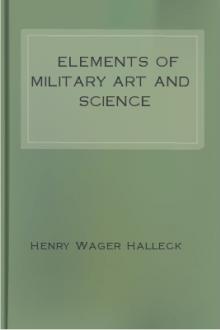Elements of Military Art and Science by Henry Wager Halleck (the speed reading book txt) 📖

- Author: Henry Wager Halleck
- Performer: -
Book online «Elements of Military Art and Science by Henry Wager Halleck (the speed reading book txt) 📖». Author Henry Wager Halleck
Having explained the principal terms used in strategy, let us trace out the successive operations of war in their usual strategic relations.
We will suppose war to be declared, and the army to be just entering upon a campaign. The political and military authorities of the state determine upon the nature of the war, and select the theatre of its enterprises. The chief selects certain points, on or near the borders of the seat of war, where his troops are to be assembled, and his materiel collected. These points, together, form his base of operations. He now selects some point, within the theatre of the war, as the first object of his enterprises, and chooses the line of operations most advantageous for reaching this objective point. The temporary positions taken on this line become strategic positions, and the line in his rear, a line of defence. When he arrives in the vicinity of his first object, and the enemy begins to oppose his enterprises, he must force this enemy to retreat, either by an attack or by manœuvres. For this purpose he temporarily adopts certain lines of manœuvre, which may deviate from his general line of operations. The ulterior events of the campaign may possibly cause him to make these new, or accidental lines, his lines of operations. The approach of hostile forces may cause him to detach secondary corps on secondary lines; or to divide his army, and pursue double or multiple lines. The primitive object may also be relinquished, and new ones proposed, with new lines and new plans of operations. As he advances far from his primitive base, he forms new dépôts and lines of magazines. He may encounter natural and artificial obstacles. To cross large rivers in the face of an enemy is a hazardous operation; and he requires all the art of the engineer in constructing bridges, and securing a safe passage for his army. If a fortified place is to be taken, he will detach a siege corps, and either continue his march with the main army, or take a strategic position to cover this siege. Thus Napoleon, in 1796, with an army of only 50,000 combatants, could not venture to penetrate into Austria, with Mantua and its garrison of 25,000 men in his rear, and an Austrian force of 40,000 before him. But in 1806 the great superiority of his army enabled him to detach forces to besiege the principal fortresses of Silesia, and still to continue his operations with his principal forces. The chief of the army may meet the enemy under circumstances such as to induce or compel him to give battle. If he should be victorious, the enemy must be pursued and harassed to the uttermost. If he should be defeated, he must form the best plan, and provide the best means of retreat. If possible, he must take shelter in some line of fortifications, and prepare to resume the offensive. Lines of intrenchment and temporary works may sometimes serve him as a sufficient protection. Finally, when the unfavorable season compels him to suspend his operations, he will go into winter cantonments, and prepare for a new campaign.
Such are the ordinary operations of war: its relations to strategy must be evident, even to the most superficial reader.
Not unfrequently the results of a campaign depend more upon the strategic operations of an army, than upon its victories gained in actual combat. Tactics, or movements within the range of the enemy's cannon, is therefore subordinate to the choice of positions: if the field of battle be properly chosen, success will be decisive, and the loss of the battle not disastrous; whereas, if selected without reference to the principles of the science, the victory, if gained, might be barren, and defeat, if suffered, totally fatal: thus demonstrating the truth of Napoleon's maxim, that success is oftener due to the genius of the general, and to the nature of the theatre of war, than to the number and bravery of the soldiers. (Maxim 17, 18.)
We have a striking illustration of this in the French army of the Danube, which, from the left wing of General Kray, marched rapidly through Switzerland to the right extremity of the Austrian line, "and by this movement alone conquered all the country between the Rhine and Danube without pulling a trigger."
Again, in 1805, the army of Mack was completely paralyzed, and the main body forced to surrender, at Ulm, without a single important battle. In 1806, the Prussians were essentially defeated even before the battle of Jena. The operations about Heilesberg, in 1807, the advance upon Madrid, in 1808, the manœuvres about Ratisbon, in 1809, the operations of the French in 1814, and the first part of the campaign of 1815, against vastly superior numbers, are all familiar proofs of the truth of the maxim.
Strategy may therefore be regarded as the most important, though least understood, of all the branches of the military art.[4]
[4]
Strategy may be learned from didactic works or from general military histories. There are very few good elementary works on this branch of the military art. The general treatises of the Archduke Charles, and of General Wagner, in German, (the former has been translated into French,) are considered as the best. The discussions of Jomini on this subject in his great work on the military art, are exceedingly valuable; also the writings of Rocquancourt, Jacquinot de Presle, and Gay de Vernon. The last of these has been translated into English, but the translation is exceedingly inaccurate. The military histories of Lloyd, Templehoff, Jomini, the Archduke Charles, Grimoard, Gravert, Souchet, St. Cyr, Beauvais, Laverne, Stutterheim, Wagner, Kausler, Gourgaud and Montholon, Foy, Mathieu Dumas, Ségur, Pelet, Koch, Clausewitz, and Thiers, may be read with great advantage. Napier's History of the Peninsular War is the only English History that is of any value as a military work: it is a most excellent book. Alison's great History of Europe is utterly worthless to the military man; the author is ignorant of the first principles of the military art, and nearly every page is filled with the grossest blunders.
We subjoin the titles of a few of the best works that treat of strategy, either directly or in connection with military history.
Principes de la Stratégie, &c., par le Prince Charles, traduit de l'Allemand, 3 vols. in 8vo. This is a work of great merit. The technical terms, however, are very loosely employed.
Précis de l'Art de la Guerre, par le Baron Jomini. His chapter on strategy embodies the principles of this branch of the art.
Grundsätze der Strategic, Von Wagner.
Cours Elémentaire d'Art et d'Histoire Militaire, par Rocquancourt. This work contains much valuable information connected with the history of the art of war; but it is far too diffuse and ill-arranged for an elementary book.
Cours d'Art et d'Histoire Militaire, par Jacquinot de Presle. This work is especially designed for cavalry officers, and the other branches of military service are but very briefly discussed.
De Vernon's Treatise on the Science of War and Fortification contains much valuable information; but, as an elementary book, it has the same objections as that of Rocquancourt.
History of the Seven Years' War, by Lloyd and Templehoff. The military writings of Lloyd and Templehoff are valuable as connected with the history of strategy; but many of the principles laid down by these writers are now regarded as erroneous.
Mémoires de Napoléon. The Memoirs of Napoleon, as dictated by himself to Gourgaud and Montholon, have been translated into English. It is hardly necessary to remark that they contain all the general principles of military art and science. No military man should fail to study them thoroughly. The matter is so condensed, and important principles are embodied in so few words, that they are not easily understood by the ordinary reader, and probably will never be popular with the multitude.
Essai général de Tactique, par Guibert. A work very popular in its day, but now far less valuable than the writings already mentioned.
Ausführliche Beschreibung der Schlacht des Pirmasens, von Gravert. Regarded by military men as a valuable historical fragment.
Mémoires sur les Campagnes en Espagne. Souchet.
Mémoires de Gouvion St. Cyr.
Statistique de la Guerre, par Reveroni St. Cyr.
Première Campagnes de la Revolution, par Grimoard.
Victoires et Conquêtes. Beauvais.
Campagnes de Suwarrow. Laverne.
Histoire de la Guerre de la Péninsule. Foy.
Précis des Evénements Militaires. Mathieu Dumas.
Histoire de Napoléon et de la Grande Armée en 1812. Ségur
Mémoires sur la Guerre de 1809. Pelet.
La Campagne de 1814. Koch.
Vom Kriege—Die Feldzügge, &c. Clausewitz.
La Révolution, le Consulat et l'Empire. Thiers.
Mémoires sur la Guerre de 1812—sur la Campagne du Vice roi en Italie, en 1813 et 1814; Histoire de la Guerre en Allemagne en 1814; Histoire des Campagnes de 1814 et 1815, en France. Vaudoncourt.
Essai sur l'Art Militaire, &c. Carion-Nisas.
Histoire de l'Expédition en Russie en 1812. Chambray.
War in Spain, Portugal, and the South of France. John Jones.
Peninsular War. Napier.
Notices of the War of 1812. Armstrong
All the above are works of merit; but none are more valuable to the military man than the military histories of Jomini and Kausler, with their splendid diagrams and maps.
CHAPTER III.FORTIFICATIONS.
Fortifications, or engineering, may be considered with reference to the defence of states and the grand operation of armies; or with reference to the details of the construction, and attack, and defence of forts, and the influence of field-works on the tactical manœuvres of armies. It is proposed to speak here only of its general character, as a branch of the military art, without entering into any professional discussion of details.
The connection of fortification and strategy may be considered under two distinct heads: 1st, the choice of sites for constructing fortresses for defence; 2d, their influence in offensive operations, and the determination of the question whether they can be passed with safety, or whether the attacking force will be under the necessity of besieging them.
The centre and extremities of a base of operations should always be secured either by natural or artificial obstacles. This base is generally chosen so that fortifications will be necessary for strengthening only a part of the line. But if a frontier, like the side of France towards Belgium, be destitute of natural obstacles, the artificial means of defence must be proportionally increased. Great care should be taken that permanent fortifications be made only on such places as may favor military operations. If otherwise, the troops detached from the active army for garrisoning them, will only tend to weaken this force without any corresponding advantages. In this way, fortifications may become actually injurious to defence. A number of the European fortresses which were built before the subject of strategy was properly understood, are now regarded as utterly useless, from their ill-advised positions.
Whether a fortress may be safely passed with merely blockading or observing it, depends very much upon the nature of the war, and the numbers and position of the defensive army. The allies, in 1814, invading France with a million of soldiers, assisted by the political diversion of factions and Bourbonists within the kingdom, and treason in the frontier fortresses, and even in the ranks of Napoleon's army, could conduct their military operations on a very different plan from that which would be adopted by either Austria, Prussia, Russia, England, Spain, Portugal, Holland, Italy, and the German powers, if singly waging war with the French. Napoleon sometimes detached





Comments (0)